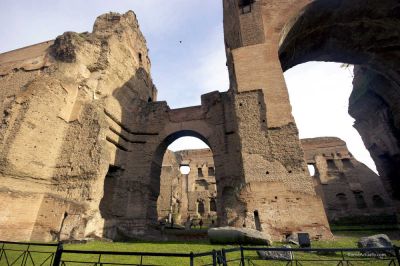A Glimpse into Ancient Roman Luxury
L'articolo descrive le Terme di Caracalla che si trovano nel centro di Roma, costruite nel II secolo. Gli antichi romani usarono le terme non solo per lavarsi ma anche per socializzare. Furono simbolo pubblico del potere e della cultura romana nonché un centro per i cittadini poiché costituite da impianti sportivi, luoghi di relax e ampi giardini. L'area intorno alle terme offriva anche delle biblioteche, negozi e ristoranti. Le terme ebbero anche numerosi affreschi, mosaici, sculture e opere d'arte. Le terme di Caracalla sono oggi patrimonio dell'UNESCO e attirano ogni giorno numerosi turisti.
In the heart of Rome lies a testament to the grandeur and opulence of the ancient Roman Empire: The Baths of Caracalla. Built between 212 and 216 A.D. during the reign of Emperor Caracalla, these immense thermal baths were not merely utilitarian structures but elaborate complexes designed to accommodate thousands of citizens daily. Beyond providing basic hygiene, the baths served as social hubs, places of leisure, and symbols of Roman power and culture.
The Baths of Caracalla were among the largest and most impressive public baths in ancient Rome, covering an area of approximately 25 hectares (one square mile). Constructed from brick and concrete, the complex boasted towering walls and soaring vaulted ceilings, showcasing the architectural prowess of the time.
At the heart of the baths was the frigidarium, a cold-water pool, flanked by two caldariums (hot rooms) and a tepidarium (warm room), all heated by a sophisticated system of underground furnaces known as hypocausts. These hypocausts circulated hot air under the floors and through the walls, ensuring a constant and comfortable temperature throughout the baths.
Beyond their functional purpose, the Baths of Caracalla were vibrant social centers where Romans from all walks of life converged. Citizens would spend hours indulging in various activities, from bathing in the pools to exercising in the gymnasiums, playing ball games in the open courtyards, or simply lounging in the gardens.
The baths were also equipped with libraries, lecture halls, and even shops and restaurants, providing visitors with opportunities for intellectual stimulation, entertainment, and refreshment. For many Romans, a visit to the baths was not just about cleansing the body but also about nourishing the mind and spirit.
The Baths of Caracalla were not devoid of artistic beauty either. The walls and ceilings were adorned with intricate mosaics, colorful frescoes, and marble sculptures, depicting mythological scenes, landscapes, and portraits of emperors and gods. These artistic embellishments added to the grandeur of the baths and reflected the cultural sophistication of the Roman Empire.
One of the most notable features of the baths was the vast central hall, known as the natatio, which housed a massive swimming pool surrounded by columns and statues. Here, bathers could swim and relax amidst an atmosphere of unparalleled splendor, surrounded by the finest works of art and architecture.
Despite the fall of the Roman Empire and centuries of neglect and pillaging, the Baths of Caracalla have managed to survive in remarkably good condition. Today, they stand as a UNESCO World Heritage Site and a testament to the ingenuity and magnificence of ancient Roman engineering and design.
Visitors from around the world flock to the Baths of Caracalla to marvel at their architectural grandeur, explore their historical significance, and imagine themselves stepping back in time to experience the luxury and leisure of ancient Rome. As one wanders through the sprawling ruins, it's easy to envision the bustling crowds, the echoing laughter, and the timeless allure of this remarkable monument to human achievement.



